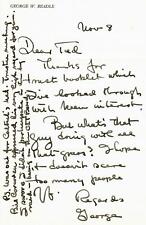"Nobel Prize in Chemistry" Ben Feringa Signed 4X6 Color Photo For Sale

When you click on links to various merchants on this site and make a purchase, this can result in this site earning a commission. Affiliate programs and affiliations include, but are not limited to, the eBay Partner Network.
"Nobel Prize in Chemistry" Ben Feringa Signed 4X6 Color Photo:
$129.99
Up for sale the "Nobel Prize in Chemistry" Ben Feringa Hand Signed 4X6 Color Photo (signed on reverse).
ES-7059
Bernard Lucas Feringa (Dutch pronunciation: [ˈbɛrnɑrt ˈlykɑs ˈbɛn ˈfeːrɪŋɣaː], born 18 May 1951) is a Dutch synthetic organic chemist, specializing in molecular nanotechnology and homogeneous catalysis. He is the Jacobus van 't Hoff Distinguished Professor of Molecular Sciences, at the Stratingh Institute for Chemistry, University of Groningen, Netherlands, and an Academy Professor and Chair of Board of the Science Division of the Royal Netherlands Academy of Sciences. He was awarded the 2016 Nobel Prize in Chemistry, together with Sir J. Fraser Stoddart and Jean-Pierre Sauvage, "for the design and synthesis of molecular machines". Feringa was born as the son of farmer Geert Feringa (1918–1993) and his wife Lies Feringa née Hake (1924–2013). Feringa was the second of ten siblings in a Catholic family. He spent his youth on the family's farm, which is directly on the border with Germany, in Barger-Compascuum in the Bourtange moor. He is of Dutch and German descent. Among his ancestors is the settler Johann Gerhard Bekel. Together with his wife Betty Feringa, he has three daughters. He lives in Paterswolde near Groningen. Feringa received his MSc degree with distinction from the University of Groningen in 1974. He subsequently obtained a PhD degree at the same university in 1978, with the thesis titled "Asymmetric oxidation of phenols. Atropisomerism and optical activity". Following a short period at Shell in the Netherlands and the United Kingdom, he was appointed as lecturer at the University of Groningen in 1984 and Full Professor, succeeding Prof Wijnberg, in 1988. His early career was focused on homogenous catalysis and oxidation catalysis, and especially on stereochemistry with major contributions in the field of enantioselective catalysis, including monophos ligand used in asymmetric hydrogenation, asymmetric conjugate additions of organometallic reagents, including the highly reactive organolithium reagents and organic photochemistry and stereochemistry. In the 1990s, Feringa's work in stereochemistry led to major contributions in photochemistry, resulting in the first monodirectional light driven molecular rotary motor and later a molecular car (a so-called nanocar) driven by electrical impulses. Ben Feringa holds over 30 patents and has published over 650 peer reviewed research papers to date, cited more than 30,000 times and has an h-index in excess of 90. He has guided over 100 PhD students over his career. he early introduction of chiroptical molecular switches, based on the design of the first chiral overcrowded alkenes and the demonstration of optically controlled molecular switching and amplification of chirality in mesoscopic systems, lead to molecular rotary motors in which chirality plays a critical role in achieving the same function achieved by nature, for example, the unidirectional rotation of retinal in rhodopsin. This work led to the discovery of the world's first unidirectional molecular rotary motor and this work has been laying the ground-work for a key component of future molecular anotechnology i.e. nanomachines and nanorobots powered by molecular motors. Feringa's design and synthesis of nanomolecular machines, specifically molecular switches and molecular motors, have initiated major novel approaches towards complex and dynamic chemical systems and the dynamic control of function. Applications of molecular switches developed in his group include responsive materials and surfaces[ liquid crystals, electrochromic devices for optoelectronics, photo-switchable DNA as a molecular memory stick, responsive gels, polymers, and light-switchable protein channels for nanoscale drug delivery systems, anion sensing, responsive catalysts and photopharmacology as well as entirely novel approaches using responsive drugs toward anticancer agents, antibiotic treatment and antibiotic resistance, and biofilm formation. Interfacing molecular motors with the macroscopic world by surface assembly on gold nanoparticles and a macroscopic gold film, has shown that the motor functions while chemically bound to a surface, a key result for future nanomachines such as a molecular conveyor belt. Experiments that involve doping liquid crystals with molecular motors demonstrate that the motion of the motor can be harnessed to make macroscopic objects rotate on a liquid crystal film and drive molecular systems out-of-equilibrium. Several of these discoveries were selected for the list of most important chemical discoveries of the year by Chemical & Engineering News. In 2011, molecular ‘nanocar’, a molecule that contains molecular motor-based wheels and was shown to move on a solid surface upon subjection to electric current from an STM tip, was highlighted in international daily newspapers & magazines worldwide and selected by the Chinese Academy of Sciences as one of the 10 major discoveries in sciences worldwide.[ Towards the future discipline of Systems chemistry, the development of a multistage chiral catalysts which comprises an integrated supramolecular system that brings together molecular recognition, chirality transfer, catalysis, stereoelectronic control and enantio-selectivity while all these processes can be enabled or disabled via an internal motor function, moves the design and application of molecular motors to a whole new level of sophistication. Aside from molecular motors and switches, Feringa's work has crossed many disciplines and includes the use of chiral electromagnetic radiation to generate enantioselectivity, low molecular weight gelators, imaging porphyrins with STM, drying induced self-assembly, organic synthesis, CD spectroscopy, asymmetric catalysis, exploring the origins of chirality including the possibility of an extraterrestrial source and various aspects of surface science including surface modification, surface energy control and porphyrin allayers.

Related Items:
"Nobel Prize in Medicine" David Baltimore Hand Signed Album Page
$104.99
“Nobel Prize in Medicine" George Beadle Hand Written Letter COA
$174.99
"Nobel Prize in Medicine" E. Donnall Thomas Hand Written Letter
$279.99



